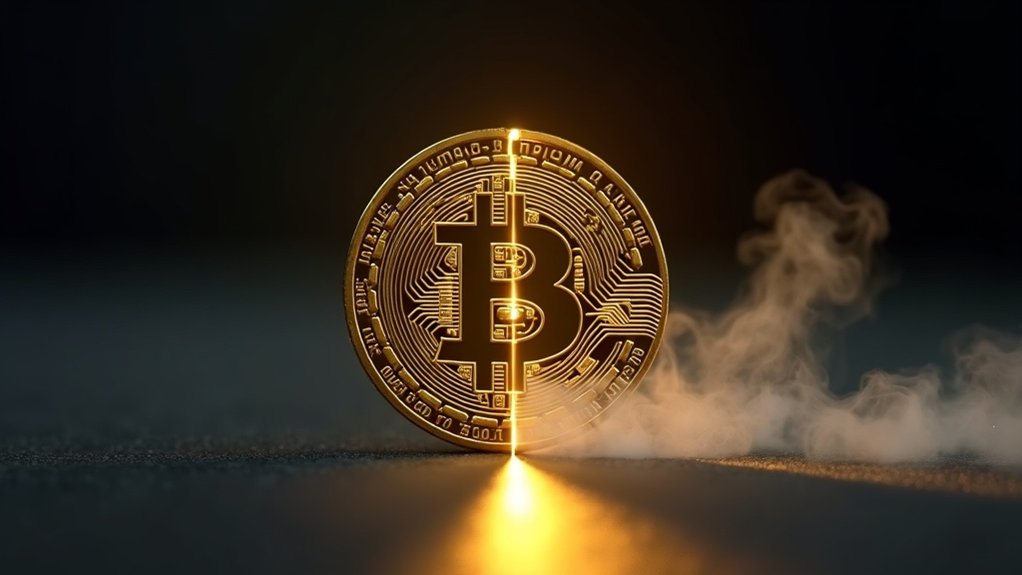Bitcoin halving is crypto’s forced diet plan. Every four years, miner rewards get slashed in half—most recently dropping from 6.25 to 3.125 BTC in April 2024. It’s Bitcoin’s way of creating artificial scarcity. With a hard cap of 21 million coins, these regular cuts guarantee Bitcoin doesn’t flood the market. Miners scramble to stay profitable, inefficient ones die off. The potential price impact? That’s the million-dollar question everyone’s trying to answer.
Every four years, Bitcoin undergoes a dramatic event that sends ripples through the crypto world. This event, known as Bitcoin halving, is programmed directly into Bitcoin’s protocol. It automatically reduces the reward miners receive for validating new blocks by 50%. Not a small change. The most recent halving occurred in April 2024, dropping the reward from 6.25 to 3.125 BTC. That’s just how it works.
Bitcoin’s creator designed halving to promote scarcity. Like clockwork, every 210,000 blocks—approximately four years—fewer new bitcoins enter circulation. It’s economics 101: limit supply, potentially increase value. The system guarantees Bitcoin can never exceed 21 million coins. Ever.
Previous halvings happened in 2012, 2016, and 2020. Each time, miners got less for doing the same work. The network security level depends heavily on miners continuing their operations despite reduced rewards.
Miners aren’t thrilled about this, obviously. They solve complex cryptographic puzzles, maintain the blockchain network, and suddenly—bam!—their rewards are cut in half. Imagine your boss announcing your salary is now 50% less. Not exactly motivation to keep showing up.
Yet miners adapt. The efficient ones upgrade equipment, find cheaper electricity, or scale operations. The inefficient ones? They disappear.
This matters because Bitcoin’s entire economic model hinges on this controlled supply reduction. Unlike governments that print money whenever they want, Bitcoin follows strict rules. The blockchain, maintained by over 56,000 nodes worldwide, enforces these rules without exception. No exceptions, no special treatment.
For the broader market, halving creates interesting dynamics. Lower supply growth with steady or increasing demand? You do the math. But it’s not guaranteed. Markets are weird. People are weirder.
The halving doesn’t affect transaction speeds or fees directly. This mechanism specifically counters inflation by maintaining Bitcoin’s finite supply while the network keeps running, blocks keep getting mined every ten minutes. Just with fewer rewards for those doing the mining. Bitcoin’s hash rate may decrease temporarily following each halving as less profitable miners exit the network. Welcome to Bitcoin’s self-regulating economy.
Frequently Asked Questions
How Does Halving Affect Bitcoin Miners’ Profitability?
Halving slashes miners’ bitcoin rewards by 50%. Simple math. Profitability takes an immediate hit—many miners can’t survive the shock.
The efficient ones? They scramble to cut electricity costs, upgrade equipment, or secure cheaper power. Some consolidate or get bought out. Others just fail.
Miners pray for price increases to offset their losses. It’s brutal economics. Adapt or die. Those with deep pockets and low operating costs usually weather the storm.
Can Halving Trigger a Bitcoin Price Crash?
Halving alone rarely causes crashes. History shows the opposite—price increases follow halvings long-term.
Short-term? Sure, some volatility happens. Miner capitulation can trigger temporary dips if bitcoin’s price doesn’t support their operations. Overleveraged traders getting squeezed might amplify downturns too.
But real crashes need additional negative catalysts beyond halving mechanics. Previous halvings sparked bull runs, not sustained crashes.
The market might wobble, but halving itself isn’t the crash culprit.
Do Other Cryptocurrencies Undergo Halving Events?
Yes, several cryptocurrencies beyond Bitcoin implement halving events. Litecoin, Bitcoin Cash, and Zcash all reduce mining rewards by half periodically, typically every few years.
Not all use identical systems though. Dash uses a different emission schedule. Vertcoin follows Bitcoin’s model closely.
These halvings serve the same purpose: controlling inflation and creating scarcity. Different block times mean different halving schedules.
Crypto projects copied Bitcoin’s homework, but some added their own twist.
How Do Exchanges Prepare for Bitcoin Halving?
Exchanges don’t mess around with halving. They scale infrastructure to handle increased trading volumes and beef up security against cyber threats.
Smart ones diversify revenue streams beyond Bitcoin and adjust fee structures. They monitor mining activity closely and prepare for network disruptions.
Market volatility management? Critical. They implement risk tools and circuit breakers to protect traders.
And yeah, they educate users about halving impacts. Because unprepared exchanges? They’re toast.
Will Bitcoin Halving Eventually Stop Occurring?
Yes, Bitcoin halving will eventually stop. It’s not an eternal process, folks.
The halving mechanism will continue until approximately 2140 when all 21 million bitcoins are mined. After that? Game over for new coin creation.
Miners will shift from block rewards to surviving solely on transaction fees.
The whole point of halving is to create a predictable path to Bitcoin’s finite supply – once we hit that supply cap, halving becomes irrelevant.









